More properly referred to as “Protein” glues – includes glues made from bone, hide, rabbit skin, fish, isinglass, and various forms of the above (eg. disiccated, liquid, and preparations of, such as Old Brown Glue “OBG”).
Source: All about fish glue and hide glue – Journeyman’s Journal
All about fish glue and hide glue
Brief History
Fish glue apparently was ordinarily available in the third century, since Hippolytus notes its use by magicians and diviners on the streets of Rome, in about 220 C.E. According to Hippolytus, fish glue had asbestos like properties, since the trickster “anoints his feet with fish glue” so that he can walk over hot coals without being burned.
A translation of Dioscorides of Anazarbus from an ancient Greek text of what fish glue is made from.
“Ichthyokolla is the stomach of a whale sized fish. The best kind is made in Pontus, and it is white, rather thick, and not scaly, and melts with a low heat (very rapidly). It is useful in making plasters for the head (skull fractures) and has properties appropriate for the treatment of Leprosies and in the manufacture of lotions that erase wrinkles from the face.”
Ladies, before you go out and slap fish glue over your faces note the translation reads “used in the manufacture of lotions” so obviously, there must be other agents mixed with it.
A Caspian fisherman who is presumed to be an eye witness, accounts in the making of fish glue and it’s workings:
“they take out the guts and boil them, and make from this a glue that is very useful, since it holds all things together quite firmly, and sticks to whatever it has been attached, and dries very shiny. And it binds everything that it holds and unites, so tightly that even if it is soaked in water for up to ten days, it will not dissolve or come apart. Moreover, Ivory carvers use it and produce very beautiful pieces.”
Fish glue usually is soluble, to render it insoluble it will need to be in contact with metal ions that also applies to hide glue.
Fish glue is a transparent, colourless, water soluble glue. There are various types of fish glues. The higher quality Isinglass to the lower quality, made from the skins of non oily types of fish as well as their bones and cartilage which are sold in liquid format. The agglutinating agents are removed by extraction with hot water, then cooled and dried to produce gelatin or glue. Varied production techniques can produce poor quality fish glues.
The highest quality fish glue is Isinglass which is made from the swim air bladders of Sturgeons. Isinglass was originally made from air bladders of the great Russian Beluga Sturgeon, found in the fresh waters of the Caspian and Black seas. The Beluga is a monstrous sized fish than can live up to 113 years.

Unfortunately, due to its overfishing the Beluga has been placed on the endangered species list which has prompted many governments worldwide to place restrictions on its trade.
In 1939, restrictions were placed on Russian exports, it’s unclear to me whether these export restrictions were solely placed on the export of this fish or on all Russian exports. However due to this, other fish air bladders were used from various fish and Isinglass became a generic term used. North American Isinglass is made from Cod or Hake.
To prepare Isinglass, the air bladders are removed from the fish, cleaned and air dried. The dried bladder is then cut into thin translucent strips, these strips which are nearly 80% collagen are dissolved in hot water then diluted and cooled into flat disks. Collagen is a protein found in cartilages, tendons, bones etc. This is a very strong and soluble adhesive that can be used in low concentrations. Sturgeon glue is rarely available outside of Russia.
Genuine Isinglass fish glue costs around 578 euros/kg or 57.80 per 100 grams (3.5 ounces) Here is the link to where you can purchase genuine Isinglass fish glue https://www.dictum.com/en/surfaces/glue-accessories/natural-glues/450142/isinglass-glue-granulate
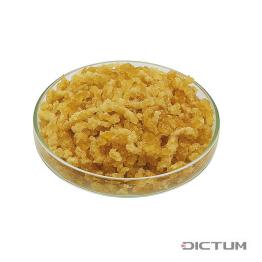
Another link but more expensive:
http://shop.kremerpigments.com/en/mediums-binders-und-glues/water-soluble-binders/natural-glues-und-agglutinants/5721/parchment-glue
The purity of Isinglass can vary due to the diverse manufacturing processes, unfortunately there is no way to verify any of the processes. Germany is usually a good source for trusted companies, Milligan and Higgins in the US is definitely a trusted company for hide glue, but I don’t know if they have Isinglass as they have not yet responded to my email. Behlen, I also don’t know what type of hide glue they sell as there is a variety of low to high grade which I will go into detail later. I haven’t also located any of their products that indicate that they sell Isinglass. Lee Valley sells liquid fish glue which is of a lower grade and the one I have, I have tested it despite it being over 5 years old and has worked remarkably well. I have tried with full force to break the pieces apart and cannot do so and remember this is with a lower grade fish glue.
Fish glue is often sensitive to changes in humidity and temperature and can shrink while drying. It doesn’t gel which means you have a long open time; some reports claim 30 mins while others claim 1.5 -2 hrs. It also means you can work in cooler conditions without the need to warm the work prior to gluing. You also apply the glue in its cold state so there’s no heating involved like hot hide glue or liquid hide glue.
Fish glue cleans up with water well whilst still wet, but difficult to clean once its dry. You can also refrigerate it and it will last for many years, the cold prevents the bacteria from forming but also increases the viscosity, so prior to use let it sit at room temperature for about an hour for it to return to its normal viscosity. If frozen you will render the glue useless, once in every few months shake the bottle to prolong its life.
Technical detail simplified – Bloom Strength
Bloom strength means gel strength and is measured in grams or another term is bloom grams, they could have easily picked one word. Manufacturers commonly distinguish between grades of glue by their bloom strength, which usually covers a wide range starting as low as 30g for weak bone glue, to rigorously extracted hide glues up to 500g being a very strong glue.
Gelatins extracted from cold water fish do not have specified gel strengths as they are liquid at room temperature.
Open time, tack and drying
The setting time of animal glues depends primarily on gelling temperature which is known as T gel and gel strength. The lower the T gel and gel strength, the longer the open time of the solution, another words the longer it takes for the glue to gel. High Bloom hot hide glues tend to gel rapidly as gelation occurs at comparatively high temperatures. Gelatinous glues derived from fish have a low T gel due to their chemical structure, and cold set liquid hide glues, are convenient to use when long open times are required. Commercial fish glues usually contain preservatives and, sometimes, small amounts of other additives such as colour brightener, deodorising agents or fragrance. Liquid
hide glues generally have further additives to inhibit gelation at room temperature. These are typically salts, like urea, thiourea or phenols that extend the setting time by inhibiting renaturation of the gelatinous matrix. Some manufacturers claim that their liquid hide glues does not contain gelling inhibitors in which case the gelatinous matrix must be considerably affected by molecular cleavage, and it’s not the hollow between a woman’s breast. Molecular cleavage means molecular separation to achieve the comparatively low molecular weight that is necessary for the glue to be in a liquid state.
In general, glues of higher bloom strength develop tack faster than lower bloom glues.
The tack strength of glues can be tested between the two finger tips.

Isinglass solutions may appear to be less tacky than equivalent concentrations of hide glue, as they take longer to set at room temperature since their lower gelation temperature delays the development of tack.
Drying times depends upon the ambient temperature and relative humidity. Glues dry by evaporation of water however; the drying times can be increased raising the room temperature. It is recommended that these adhesives be allowed to dry as slowly as possible to maximise the elasticity and strength or should I say toughness of the glue film.
Isinglass naturally develops highly stable and elastic films if dried at room temperature, being slightly above its temperature gel. It’s interesting to note if I may back track a little, that heating these glues at high temperatures say 80c or 90c would result in only small amount of loss of strength if only done for a few minutes, anymore would render the glue useless.
Viscosity meaning thickness is an important factor in the choice of adhesive for bonding or consolidation, as it will affect the degree of penetration into a substrate. If the viscosity is too low the glue may penetrate too far into the wood, leaving the joint starved of adhesive. For consolidation of porous materials, high viscosity may prevent adequate penetration and cause stress to develop at the interface between consolidated and unconsolidated areas.
Isinglass has a much higher viscosity than hide glue, in order to obtain glue solutions of low viscosity it is not always advisable to over dilute high bloom glues excessively, hide glue is a high bloom glue. If you did so, you would weaken its strength, leeching, swelling and staining the wood may result if it is water sensitive. In this case, a lower gel strength glue would be preferable. Slow gelation and lower viscosity promote uniform film formation as glue is able to spread evenly, providing adequate wetting of the surface, then again using a larger natural bristle brush will achieve the same result.
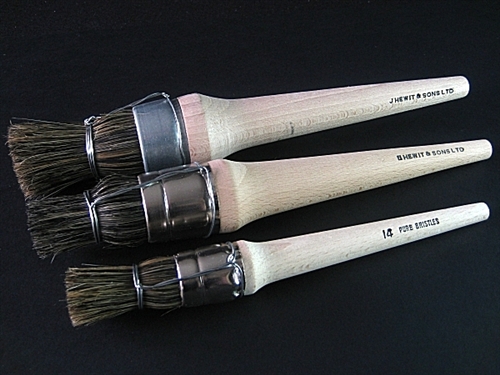
Hide glues generally have greater cohesive strength than bone glues which display a lower tensile strength and are much more brittle.
The tensile strength of hide glues is typically around 39 megapascals (MPa) (5700 psi) A tensile strength is the maximum strength that can be applied to it before it breaks, that’s pretty darn strong in my books. Cold water fish gelatins show a comparatively low tensile strength of around 22MPa (3200 psi) which again is very bloody strong. A high tensile strength similar to that of hide glue has been reported for mildly prepared Isinglass from Sturgeon, making it a useful adhesive for bonding wooden joints. Literature confirms that Isinglass has often been used for structural woodwork in the far east, to me that’s impressive.
Although Rabbit skin glue has a high gel strength, it has been stated as having a lower cohesion and bonding strength than other hide glues. This is thought to be due to its high fat content. So stay away from McDonalds.
Creep and Elasticity
Isinglass has more elasticity than hide glue. Glue recipes often contain additives such as sugar alcohols (glycerine, sorbitol) and polysaccharides (dextrins) to improve elasticity and toughness. One traditional method for achieving elastic and resilient glue films is in the addition of honey. Sugars are hygroscopic, by adding water you induce gel strength and viscosity. These additives are known as plasticisers even though they don’t actually plasticise the glue. High proportion of fat also improves the elasticity but at the cost of reducing final bond and gel strength. A high water content or an excess of hygroscopic additives like sugar, can promote an unwanted tendency to creep.
Resolubility (Reversibility)
Animal glues are well known for their resolubility or better known as reversibility, but it can be rendered insoluble if it comes in contact with metal ions e.g. Metal foils, tools, pigments), or with certain organic pigments and tannins, either before, during or even after their application. A pigment is a colourant but so is a dye, the difference between the two is that a pigment is insoluble, while a dye isn’t because it’s a liquid. Cold liquid hide and fish glues, the ingredients of which are unknown to the supplier and end user, may already contain additives that promote cross linking and, therefore, increase insolubility. I have read many reports of users claiming they had extreme difficulties pulling instruments apart for repairs. This is why I cannot stress this point enough, to always buy from a trusted source like Milligan and Higgins. I’ve never used hide glue from anyone else and therefore I cannot vouch for them but I would never buy the cheap ones offered on eBay as you just don’t know who manufactured them. There has been a lot of rave about Behlen hide glue, I don’t know because I’ve never bothered to investigate. It’s a German company and Germany is well known for quality products.
Hide Glue Preparation
Liquid Hide OBG – Heat in bottle up to 140°F (60°c)
Hot Hide Glue – Measure weight by volume of water, take how much you’re going to need and place it in a plastic or glass container NOT METAL then fill with cold water just to cover the granules and leave uncovered for half hour or best 24 hours. Heat gluepot to 140°F and cook your glue. Stir occasionally, to thin it add hot water equalling the temperature of the glue. Do not over thin it and don’t let it be too thick, if it’s thick it will gel quicker resulting in a poor bond. Clamping time minimum 12hrs best 24hrs Reactivate with heat and water.
Liquid Fish Glue – Use in a cold state (no heating required) Clamp for minimum 12 hours, best 24hrs. Cleans up with water best when glue is still wet. Reactivate with water
Isinglass (Highest Quality Fish Glue)
This is an extract from Alba Art Conservation
STEP BY STEP: HOW TO MAKE GLUE FROM FISH BLADDERS
Part of the routine activities of conservators is to make our own tools and solutions for use in conservation treatment. Many traditional materials can be found on specialty websites and in stores, but some we just prefer to mix ourselves. Isinglass is a natural and refined glue made from gelatin from cooked down sturgeon bladders. It’s optical properties, such as reversibility, aging characteristics, and strength, make it a very good choice of glue to be used in many conservation treatment applications. It is used mainly in consolidation (stabilization of flaking media), though also has applications in tear repair, facing, and as a general adhesive. I hope this blog post illustrates the care and time conservators put into selecting (and making) their materials, as well as the actual treatment of art.
First, the swim bladders of the sturgeon are purchased dried and unprocessed. They should be free of blood clots and other large inclusions. For this project, I used 50 grams of dried Salianski bladders purchased from L. Cornelissen & Son.
The swim bladders should be soaked overnight in water using approximately a 1:10 glue-to-water ratio. I eye-balled the ratio in a large glass beaker to a final volume of about 800 ml. To help them absorb water, the bladders can be cut into smaller pieces. I found this time-consuming and difficult, so I ended up soaking them whole. After a period of 24 hours, the bladders should be spongy to the touch and able to be easily pulled apart.
Once the bladders are sufficiently spongy, they should be kneaded into a homogeneous blob. The texture was kind of doughy at this point, and obtaining the blob was easier than I thought. Any hard bits should be worked into the dough. If there are a few remaining, they will be filtered out at a later stage.
The glue and water were placed in a makeshift double boiler using the glass beaker, a wooden block, and a large cooking pot. The mixture should be cooked in hot water, never exceeding 140 degrees F (60 degrees C). I allowed the glass beaker to come to temperature in the water and kept a digital thermometer in the cooking water to monitor the water temperature. To double check, I also kept a meat thermometer inserted in the water and had a glass of cold water on hand to cool the water, if necessary. As the water began to reach temperature, the mixture became cloudy as the dough began to dissolve. The solution was stirred with regularity and after about 45 minutes, the glue was mostly in solution. I found that I had to get the outside water temperature very close to 140 for the majority of the mixture to dissolve. The water eventually became more clear as the dough melted. To see that all was well, I checked the tack of the glue as it neared completion, and the results were satisfactory.
After cooking, the solution was filtered into a large glass jar through a nylon stocking. The material remaining in the stocking should be squeezed through to help dissolve any remaining bits. This solution was then re-filtered using the same stocking. Bits remaining after the second filtration can be discarded with the stocking. At this point, the solution should be yellowish and clear of bits. I poured it onto a sheet of non-stick Mylar that had been previously prepared over a large table. Incidentally, I also had to prepare an additional sheet of Mylar to accommodate the large amount of glue produced. The glue should be left undisturbed to dry. To make more homogeneous and complete sheets, I attempted to spread the glue mid-drying with a piece of stiff Mylar with some success. I did end up getting areas of pooling that took longer to dry than others.
Once the sheet is sufficiently dried, they can be easily separated from the Mylar and cut up into smaller pieces to be stored for later use.
The cut up pieces can be stored in jars and re-dissolved in water as they are needed. Though lengthy, the preparation of the glue yielded enough dried glue to last for a few years. The product is very refined and sure to contain no additional additives, bulking agents, or colorants.
For the instruction on the preparation of isinglass, I would like to give credit to my graduate painting conservation professor James Hamm at Buffalo State College and to Jill Whitten and Rob Proctor.

Qualitatively ranked comparative overview of each protein glue
I have included a table you can download. It a comparative overview of each glue
I think I have covered many useful topics and you should now have a solid understanding of the various types of animal protein glue without the unnecessary glossy scientific details which I have omitted, as it does not benefit us the woodworker in knowing it. As for the contradictory data for Isinglass from sturgeon, one test from Pryzybylo indicated that the glue was resoluble in water after both tests of natural and artificial ageing was conducted. However, another report from Michel et al. indicated that their artificially aged sturgeon isinglass was insoluble in water. As you can see these are contradictory results which may be due to different preparation procedures, light source, exposure time, temperature etc. In reference to the Caspian Sea fisherman on his eye witness accounts of where the object was soaked in water for up to ten days and did not come apart is in line with Michel’s findings, but just what preparation did the ancients use to render this glue insoluble is unknown.
Animal protein glues has many uses in all fields of many trades but there is no one particular glue that you can generalise as a general glue type. Each glue has its pros and cons and each glue will perform different tasks. As an example, you cannot use hide glue for bonding metal to wood but instead you would use Fish glue, but the same glue wouldn’t suffice for gilding, instead you would use rabbit skin glue. So, as you can see they all work differently to each other, so it’s up to you as a craftsman to understand what your glue can or cannot do, and to use the appropriate glue for the job on hand.
I think by now with how much I have written on this subject not only in this article but in all my previous ones that animal protein glues, is my go to glue.
Tips
If you are experiencing problems with your glue losing its bond as I have read on many forums from Luthiers, you need to ask yourself what quality of glue are you using. Is it from a reputable source? Very high humidity can also be the cause due to high levels of moisture in the air, dry heat is not the cause. As you know by now that Fish glue is high in viscosity, by thinning the glue you’re basically starving the joint. What little glue is on there holding your piece together will come apart in even slight humid conditions. Another factor at play is people using hair dryers to force the drying times, fish glue works best when its left to dry slowly and naturally. If your workshop is in a damp environment then don’t expect much results with any animal protein glue, if your wife’s dryer is in your workshop, your shop including all your tools and wood will be soaked. Look at your environment before you blame the glue doing what it’s supposed to do.
Your customers also need to be made aware of potential mishaps and how to avoid them. All in all, in all my years of using hide glue and this fish glue is the first for me, nothing has come apart, and conditions in my area in summer are extreme, soggy high humidity. I have also just used fish glue instead of epoxy to fill in a crack in a knot on my recently bought bowsaw, it worked wonderfully and as you know this fish glue is very old and I’m confident it hasn’t gone off. Equally it’s the lower grade one from Lee Valley not the high grade Isinglass. It’s also been several days probably a week since I glued to sample together, still its impossible to break it apart. I will give it a test in the laundry when my wife uses the dryer next, just to see if it will come apart and that will the most extreme conditions.
If you’ve read this far then congratulations are in order, this length of post isn’t the norm for blogs but I do hope I will make a regular habit of it.
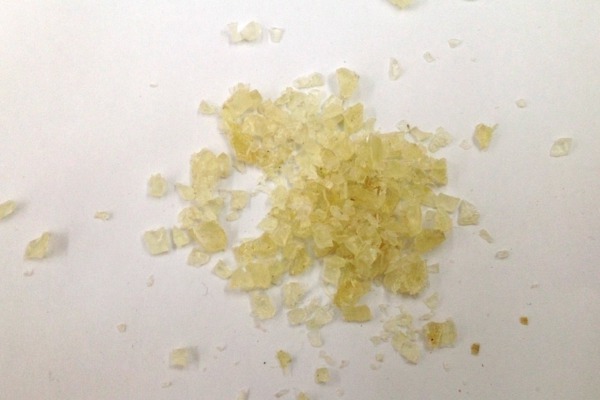

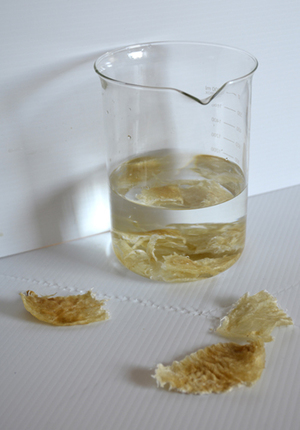
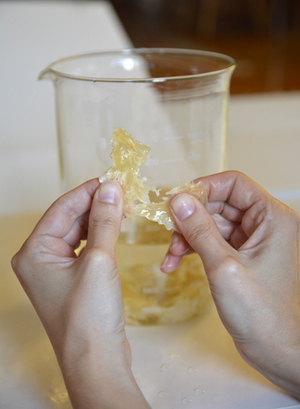

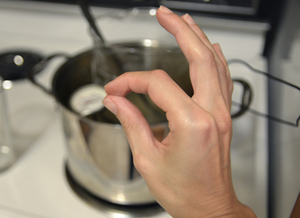





Comments